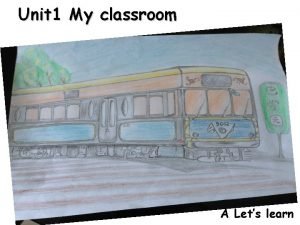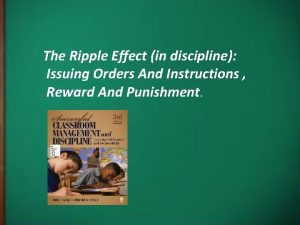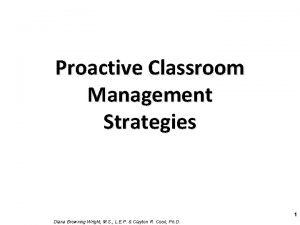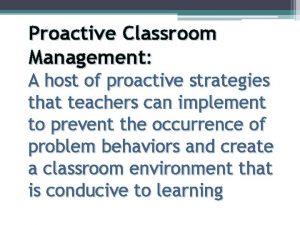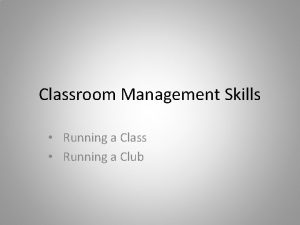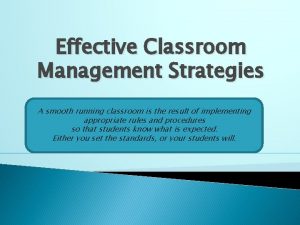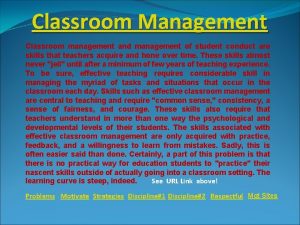Classroom Management Skills Running a Class Running a















- Slides: 15

Classroom Management Skills • Running a Class • Running a Club

Running a Class 1. Establish Roles • Tutor’s Role – Chess ! – Keeping the children enthused – Keeping the teacher on side • Teacher’s Role – Discipline – Joining in ! – Helping with difficult children

Running a Class 2. Learn Names • Teacher ! • Teaching Assistants • Head Teacher / Receptionist / others • Children – disruptive children – uncooperative children – shy children – keen children

Running a Class 3. Plan each lesson • Decide on your structure – Talk • Keep children and pieces apart ! – Exercise • Paper based / books / with pieces – Play

Running a Class 4. Attracting the Children’s Attention • Clapping / Hand in the air • What you expect when you have their attention – Stop talking – Stop touching the pieces – Look at the chess coach • Giving them a time limit by counting

Running a Class 5. Dividing the Class into different groups • To start – strong player with weaker players • Change to – strong players together and weaker players together • Chess Groups

Running a Class 6. Vary your teaching materials and methods • CSC Exercise Sheets – Photocopies – Individual wipe boards • CSC Exercise Books • Individual Exercises / Group Activities • Writing moves down

Running a Class 6. Explain how each lesson fits into the greater scheme of things • Introduction at the beginning of each lesson • Sum up at the end

Running a Club 1. Establish Rules • No eating at the board • Shaking hands at the beginning and end of each game • Setting up the pieces before leaving the board • Leaving the room • Method of attracting attention. . . and what you expect when you have their attention

Running a Club 2. Learn Names • Register • Swiss Pairing Cards • Labels

Running a Club 3. Divide into groups • Ideally each group has a tutor

Running a Club 4. Run Competitions • All Play All – Use 0 – 10 scoring system - rewards • • Good behaviour Good opening Trying hard Writing moves down • Swiss – Use 0 – 3 – Use 0 – 5

Running a Club 5. Watch out for intimidating behaviour • Quiet shy players can be bamboozled by more vocal seemingly confident players. • If there is a dispute insist you are called • Never allow the word “Cheat” to be used. Explain that everyone is learning and we all made mistakes • Agree protocols eg touch piece move piece • Never allow fist pumping / gloating etc • Congratulate the winner but try to find some aspect about the loser’s game that you can praise, and some aspect that they could improve on so that they move from being a loser to a learner

Running a Club 5. Stay positive • Children have chosen to attend the club in their own time and you want them to return • Children teach other so relax !

Running a Club 5. Feedback • Tell children and parents where and when they can play more chess – Local chess club – External competitions – Online
 In the old days there lived
In the old days there lived Running running running
Running running running Smart classroom vs traditional classroom
Smart classroom vs traditional classroom Skillsforlove.com
Skillsforlove.com My classroom for class 1
My classroom for class 1 Google classroom class codes
Google classroom class codes Intra personal skills
Intra personal skills Hard skills for resume
Hard skills for resume Essential skills ontario
Essential skills ontario Jacob kounin ripple effect
Jacob kounin ripple effect Diana browning
Diana browning 17 proactive classroom management strategies
17 proactive classroom management strategies Diana browning wright
Diana browning wright Pbis classroom management checklist
Pbis classroom management checklist Teacher professional growth plan examples
Teacher professional growth plan examples Key elements for effective classroom management a checklist
Key elements for effective classroom management a checklist




